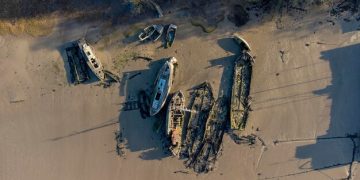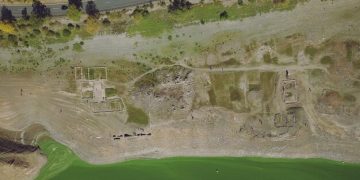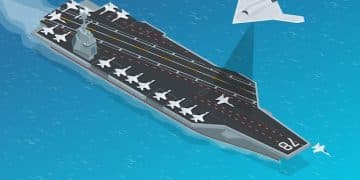US Military’s Arctic Focus: Strategic Implications and Future Warfare
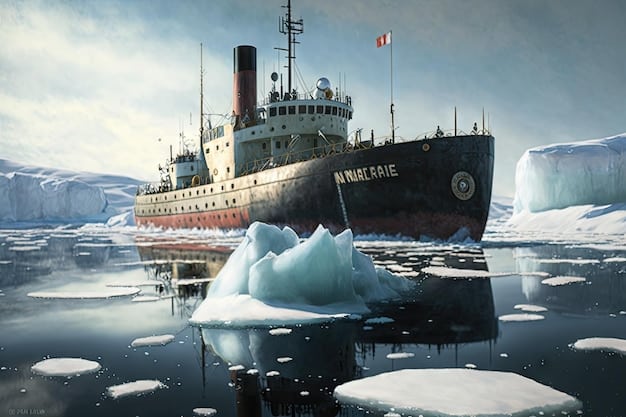
US Military’s Focus on Arctic Warfare: Understanding the Strategic Implications involves adapting strategies and technologies to maintain security and project power in the increasingly accessible and strategically vital Arctic region.
The Arctic is no longer a frozen, remote frontier. As climate change melts ice and opens new sea routes, the region is becoming increasingly accessible and strategically important. This shift has triggered US Military’s Focus on Arctic Warfare: Understanding the Strategic Implications. The thawing Arctic presents both opportunities and challenges for the United States. As other nations, particularly Russia and China, assert their presence in the Arctic, the US military is actively adapting its strategies, training, and technology to maintain its competitive edge in this critical region. The US military’s heightened attention towards the Arctic reflects a broader strategic imperative to protect its interests and ensure stability in a rapidly changing geopolitical landscape.
Understanding the Increasing Importance of the Arctic
The Arctic’s strategic significance is rapidly evolving due to climate change and shifting geopolitical dynamics. As ice melts, new shipping lanes and resource opportunities emerge, making the region more accessible to both military and commercial interests. This increased accessibility has led to a growing competition amongst nations vying for influence and control in the Arctic, further underlining the importance of understanding this transformation.
The Geopolitical Landscape of the Arctic
Several nations have increased their presence in the Arctic, leading to a complex geopolitical landscape. These nations, including Russia, China, Canada, and Denmark, have varying interests and approaches to the region. Understanding their respective strategies is critical for the US military to effectively navigate and maintain its strategic objectives in the Arctic.
- Russia: Expanding its military presence and infrastructure.
- China: Investing in Arctic resource extraction and scientific research.
- Canada: Asserting its sovereignty and protecting its northern territories.
- Denmark: Maintaining control over Greenland and its strategic location.
These competing interests create both opportunities and challenges for the United States. A comprehensive understanding of these dynamics is essential for effective strategic planning and execution.
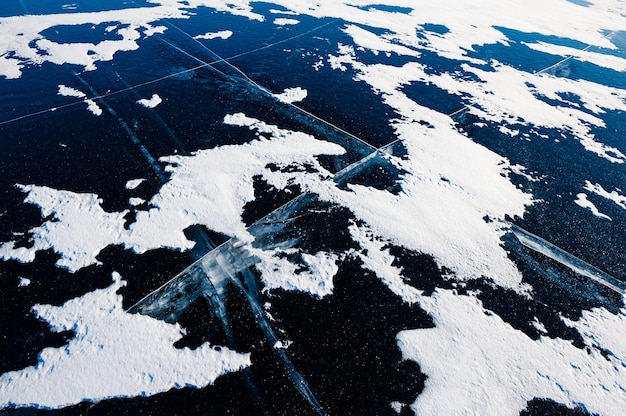
In conclusion, the Arctic’s growing importance necessitates a comprehensive understanding of its changing landscape and the competing interests of various nations. The US military’s strategic approach must be informed by these geopolitical realities to effectively safeguard its interests and promote stability in the region.
US Military’s Focus on Arctic Warfare: Understanding the Strategic Implications
In response to these growing challenges and opportunities, the US Military’s Focus on Arctic Warfare has intensified. This focus includes strategic adaptations, technological innovation, and enhanced training to operate effectively in the harsh Arctic environment. The goal is to maintain a strong presence and deterrent capability to protect US interests and allies.
Strategic Adaptations and Military Readiness
The US military is strategically adapting its forces to operate effectively in the Arctic’s unique conditions. This adaptation includes enhanced training, equipment modifications, and the development of new operational doctrines. Military readiness is crucial for responding to potential threats and maintaining stability in the region.
These strategic adaptations are vital for ensuring that the US military can effectively operate and maintain a strong deterrent capability in the Arctic. Adapting to the environment and the evolving threats are critical components of this readiness.
Technological Innovations for Arctic Operations
The US military is investing in technological innovations to enhance its capabilities in the Arctic. These innovations include improved communication systems, advanced surveillance technologies, and specialized equipment designed to withstand extreme cold and ice conditions. Technological superiority is essential for maintaining a competitive edge in the Arctic.
- Advanced Radar Systems
- Satellite Communication Networks
- Ice-Resistant Vehicles and Equipment
These technological advancements are designed to improve situational awareness, enhance operational effectiveness, and ensure the safety of US military personnel operating in the Arctic.
In summary, the US Military’s Focus on Arctic Warfare involves strategic adaptations and technological innovations to maintain military readiness and ensure a competitive advantage in the region. This proactive approach demonstrates the US commitment to protecting its interests and promoting stability in the Arctic despite the growing challenges outlined previously.
Training and Exercises in Extreme Cold Weather Conditions
Effective training and exercises are critical for preparing US military personnel for Arctic operations. These programs focus on developing the skills and knowledge necessary to survive and operate in extreme cold weather conditions. Realistic training scenarios and collaborative exercises with allies enhance readiness and interoperability.
Key Elements of Arctic Training Programs
Arctic training programs cover a range of essential skills, including cold weather survival, navigation, communication, and equipment maintenance. These programs also emphasize teamwork and leadership in challenging conditions. Specialized training ensures military personnel are fully prepared for the rigors of Arctic operations.
These key skills are essential to ensuring the success of any operation conducted in the arctic. Mastering cold-weather survival techniques can be the difference between life and death.
Collaborative Exercises with Allied Nations
The US military conducts joint exercises with allied nations to enhance interoperability and strengthen partnerships in the Arctic. These exercises provide opportunities to share best practices, coordinate strategies, and build mutual trust. Collaborative efforts are essential for maintaining regional security and stability.
- Joint Military Drills
- Information Sharing and Coordination
- Combined Operations and Planning
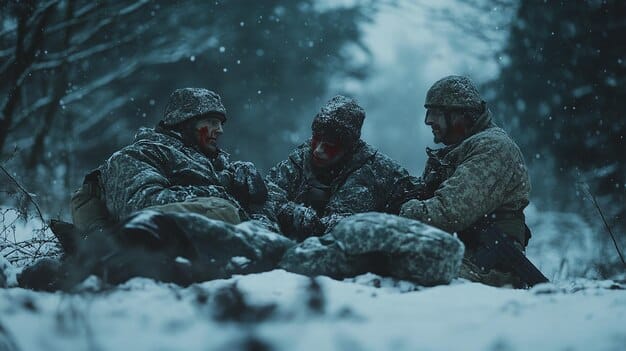
These collaborative exercises demonstrate a shared commitment to Arctic security and promote effective coordination among allied forces. The US military actively seeks to foster these partnerships to address the challenges and opportunities presented by the changing Arctic landscape.
In conclusion, comprehensive training and collaborative exercises are essential components of the US military’s Arctic strategy. By equipping personnel with the skills and knowledge needed to operate effectively in extreme cold weather conditions, the US military enhances its readiness and its ability to work seamlessly with allied nations.
The Role of Arctic Infrastructure and Logistics
Developing and maintaining robust infrastructure and logistics capabilities is vital for supporting US military operations in the Arctic. This includes establishing forward operating bases, improving transportation networks, and ensuring reliable supply chains. Adequate infrastructure and logistics are essential for sustaining a continuous presence and responding to emergencies.
Strategic Infrastructure Development
The US military is strategically investing in infrastructure development to enhance its operational capabilities in the Arctic. This includes upgrading existing facilities and establishing new bases to support a broader range of activities. Modern and resilient infrastructure is essential for projecting power and maintaining a credible deterrent.
This new infrastructure will allow not only a quick, safe, and efficient response to potential threats but also allow for the storage of resources.
Ensuring Reliable Supply Chains
Maintaining reliable supply chains is critical for providing US military personnel with the resources they need to operate effectively in the Arctic. This includes food, fuel, equipment, and medical supplies. Effective supply chain management ensures that forces are adequately supported, even in remote and challenging environments.
- Establishing Strategic Stockpiles
- Improving Transportation Networks
- Utilizing Advanced Logistics Technologies
These initiatives are designed to minimize supply chain vulnerabilities and enhance the resilience of US military operations in the Arctic. Secure and efficient logistics are essential for maintaining a sustained presence and responding to contingencies.
In summary, robust infrastructure and reliable supply chains are critical components of the US military’s Arctic strategy. By investing in strategic infrastructure development and ensuring effective supply chain management, the US military enhances its operational capabilities and sustains its presence in this strategically important region.
Future Challenges and Opportunities in Arctic Warfare
As the Arctic continues to evolve, the US military faces both challenges and opportunities in adapting to the changing environment. Strategic foresight and proactive planning are essential for addressing emerging threats and capitalizing on new possibilities. The future of Arctic warfare will require adaptability, innovation, and collaboration.
Addressing Emerging Threats
The US military must remain vigilant in addressing emerging threats in the Arctic, including those posed by adversarial nations and non-state actors. This requires continuous monitoring, intelligence gathering, and the development of effective countermeasures. Proactive threat mitigation is essential for maintaining regional security and stability.
Threat mitigation is critical and essential to prevent harm to people and essential equipment located in the Arctic.
Capitalizing on New Opportunities
The changing Arctic landscape presents new opportunities for the US military to enhance its capabilities and expand its influence. This includes exploring new technologies, forging strategic partnerships, and engaging in cooperative research and development. Capitalizing on these opportunities will strengthen the US position in the Arctic and promote mutual interests.
- Investing in Cold-Weather Research
- Promoting International Cooperation
- Developing Sustainable Arctic Strategies
These opportunities offer pathways to enhance US military capabilities, promote regional stability, and advance scientific understanding of the Arctic. By embracing innovation and collaboration, the US military can effectively navigate the challenges and opportunities that lie ahead.
In conclusion, Strategic foresight and proactive planning are crucial for the US military, and understanding the challenges and capitalizing on the opportunities of Arctic warfare will require adaptability, innovation, and collaboration. These key components will strengthen the US position in the Arctic and promote mutual interests.
| Key Point | Brief Description |
|---|---|
| ❄️ Arctic Importance | Strategic region due to melting ice and accessibility. |
| 💪 Military Focus | Adapting strategies, training, and technology. |
| 🤝 Allied Exercises | Collaborative efforts for regional security. |
| 🚀 Tech Innovation | Investing in comms and surveillance tech. |
Frequently Asked Questions
The Arctic is becoming more accessible due to climate change, leading to increased strategic competition. The US military aims to protect its interests and ensure stability in the region.
Training focuses on cold weather survival, navigation, communication, and equipment maintenance. Realistic scenarios prepare personnel for the challenges of the Arctic environment.
The US military conducts joint exercises and shares information with allied nations to enhance interoperability and strengthen partnerships for regional security. These operations are focused on projecting US Military’s Focus on Arctic Warfare: Understanding the Strategic Implications to allies.
Innovations include advanced radar systems, satellite communication networks, and ice-resistant vehicles designed to improve situational awareness and operational effectiveness.
Challenges include addressing emerging threats and adapting to the changing environment. Opportunities involve exploring new technologies and forging strategic partnerships for Arctic defense and sustainability.
Conclusion
In conclusion, the US Military’s Focus on Arctic Warfare: Understanding the Strategic Implications is essential for maintaining US interests and ensuring regional stability. Through strategic adaptations, technological innovations, comprehensive training, and collaborative partnerships, the US military is well-positioned to meet the challenges and capitalize on the opportunities presented by the evolving Arctic landscape.
